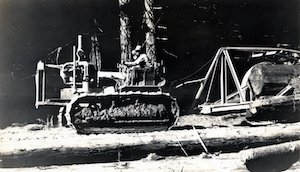
Photograph of logs being hauled to a landing by a Holt tractor. Two men are seated on the tractor.
August 7, 1921 – The first tractor ordered for use in logging the Big River woods fell through the northern end of Big River Bridge, landing on the beach and burying its nose in the sand. The Beacon reported that, “The driver of the machine was unhurt from the fall and the machine itself received no injury other than losing a grease cup.”
Months earlier, Charles B. Mallory and Woods Superintendent Ed Boyle had gone to Siskiyou County to observe a similar machine in operation, and Mallory, seeing its great potential, purchased one for his logging camp.
The 14-ton Holt tractor was delivered to Fort Bragg by train the first week of August. The plan was to drive the tractor under its own power down the coast to Mendocino, then out the Ukiah Road to Comptche. To accommodate the weight of the tractor, “bridges will be strengthened or detours made around them.” It’s unclear whether Big River Bridge had been prepared for the crossing.
“A crew of men under the supervision of John Chambers, repaired the bridge the following day. A big lighter was secured and the machine was taken across the river with little difficulty. From there it proceeded without further mishap, out the Ukiah road to Mallory’s camp where it will be used for logging purposes.”
The following week, the Beacon reported that the tractor was working out so well that the logging crews were having a hard time keeping up. “The haul to the log landing is thus far comparatively short, about 300 yards, and the donkey engine crew in the gulch are hard put to furnish enough logs to keep the big gas machine in logs. At one load, the tractor is said to have dragged an entire redwood tree measuring about 4-1/2 feet on the stump to the landing. The tree was cut into several logs which were coupled together. No skid road was built as was required for the bull teams of earlier days, the bottom of the gulch being just sufficiently cleared that the tractor would have room to operate. At the landing at the river a skidder is stationed which takes the logs and tiers them in the stream so that they will easily be moved by next winter’s freshets.”
How Mendocino Evolved by Chuck Bush – A Kelley House Museum publication covering the history of Mendocino and coastal growth during the logging years. $15.